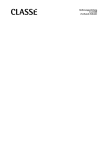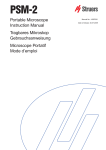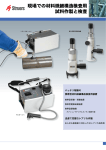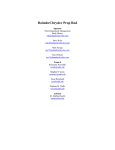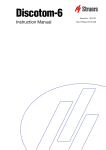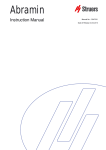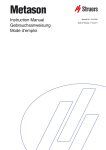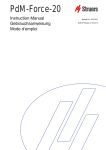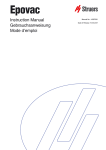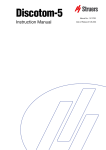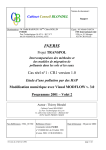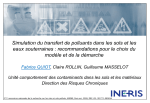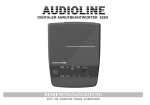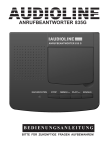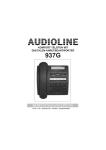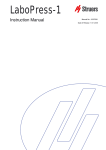Download Transpol-2
Transcript
Transpol-2 Instruction Manual Gebrauchsanweisung Mode d’emploi Manual no.: 15957001 Date of release 07.08.2007 Transpol-2 Instruction Manual Instruction Manual Always state Serial No and Voltage/frequency if you have technical questions or when ordering spare parts. You will find the Serial No. and Voltage on the type plate of the machine itself. We may also need the Date and Article No of the manual. This information is found on the front cover. The following restrictions should be observed, as violation of the restrictions may cause cancellation of Struers legal obligations: Instruction Manuals: Struers Instruction Manual may only be used in connection with Struers equipment covered by the Instruction Manual. Service Manuals: Struers Service Manual may only be used by a trained technician authorised by Struers. The Service Manual may only be used in connection with Struers equipment covered by the Service Manual. Struers assumes no responsibility for errors in the manual text/illustrations. The information in this manual is subject to changes without notice. The manual may mention accessories or parts not included in the present version of the equipment. The contents of this manual is the property of Struers. Reproduction of any part of this manual without the written permission of Struers is not allowed. All rights reserved. © Struers 2007. Struers A/S Pederstrupvej 84 DK-2750 Ballerup Denmark Telephone +45 44 600 800 Fax +45 44 600 801 Transpol-2 Instruction Manual Transpol-2 Safety Precaution Sheet To be read carefully before use 1. The operator should be fully aware of the use of the apparatus according to the Instruction Manual. 2. If grinding accessories not recommended by Struers are used, they must be approved of for speeds above 8500 rpm. Do not use grinding stones with diameter larger than 10 mm. 3. Make sure that the current-carrying parts are kept in order. If any damage to a cable has been observed it must be corrected immediately. 4. Use an isolating transformer in wet and moist rooms. 5. Always use safety goggles when working with Transpol-2. 6. Always protect the motor and control unit from rain and moisture. 7. The grinding unit must not be used without reduction gear. 8. Always clamp the grinding tools carefully. The equipment is designed for use with consumables supplied by Struers. If subjected to misuse, improper installation, alteration, neglect, accident or improper repair, Struers will accept no responsibility for damage(s) to the user or the equipment. Dismantling of any part of the equipment, during service or repair, should always be performed by a qualified technician (electromechanical, electronic, mechanical, pneumatic, etc.). Transpol-2 Instruction Manual Disposal Equipment marked with a WEEE symbol contain electrical and electronic components and must not be disposed of as general waste. Please contact your local authorities for information on the correct method of disposal in accordance with national legislation. Transpol-2 Instruction Manual Table of Contents Page 1. Getting Started Checking Contents of Packing ........................................................... 2 Mounting of Motor .............................................................................. 2 2. Operation Getting Acquainted............................................................................. 3 Coarse Grinding ................................................................................. 5 Grinding and Fine Grinding ................................................................ 5 Grinding Time ........................................................................... 6 Grinding Speed ......................................................................... 6 Grinding Pressure ..................................................................... 6 Practical Hints ........................................................................... 6 Polishing............................................................................................. 7 Overload of the Motor ........................................................................ 7 3. Maintenance............................................................................ 8 4. Technical Data ........................................................................ 8 1 Transpol-2 Instruction Manual 1. Getting Started Checking Contents of Packing In the packing case you should find the following parts: 1 Transpol-2 1 Carrying case with shoulder strap 1 Mains cable 1 DC motor 1 Reduction gear 1 Straight handle with holder for flapper wheel 1 Flapper wheel, grit 80 1 Right angle handle with quick coupling for rubber discs 4 Rubber discs 1 Felt cone 1 Square box for storing polishing cloths and felt cone in use 3 Spanners for tightening grinding tool 1 Spanner 1 Lock pin for use when clamping flapper wheel 1 Pair of safety goggles 2 Fuses 1 Set of Instruction Manuals Mounting of Motor Place the plug of the motor cable in the socket on the front plate and tighten the nut. Screw motor and reduction gear carefully together. If the parts cannot be screwed correctly together it is because the driver of the motor is not correctly positioned. By turning the motor shaft the parts can be made to line up and then be tightened up with the spanner. Never use force! IMPORTANT The reduction gear must remain mounted on the motor, whether the straight handle or the right angle handle is to be used. 2 Transpol-2 Instruction Manual 2. Operation Getting Acquainted Take a moment to familiarise yourself with the location and names of all the Transpol-2 components: Front Panel de c c d e f g h i f g h i Main switch Overload indicator Start/ Stop button Speed display Change direction button and direction indicators Speed control Socket for motor cable 3 Transpol-2 Instruction Manual c Front Panel d Carrying case with shoulder strap h Right angle handle with quick coupling for rubber discs 1 Rubber disc g Felt cone f Boxes for storing new grinding discs and polishing cloths (consumables are ordered separately) i DC motor e Box for storing polishing cloths and felt cone in use j Reduction gear 2 Spanner and lock pin for k Straight handle with 6 mm chuck for flapper wheel l Flapper wheel 4 tightening grinding tool Transpol-2 Instruction Manual Coarse Grinding Grinding and Fine Grinding Screw the straight handle on the reduction gear in the same way as the reduction gear was mounted on the motor. Place the flapper wheel in the handle, put the lock pin in the hole in the middle of the handle and fasten the flapper wheel in the handle with the spanner. Switch the mains switch to ON. The display will light up. Press the Start/ Stop button and the motor starts rotating. Adjust the speed as required. Coarse grinding with flapper wheel requires the highest speed. Dismount the straight handle (the reduction gear must remain mounted on the motor). Mount the right angle handle and tighten it with the spanner in the same way as the reduction gear was mounted on the motor. Place the rubber disc in the quick coupling device of the right angle handle. Hold back on the angle head with your thumb and at the same time turn the rubber wheel and press it into place. Take a piece of grinding paper with the appropriate grit size. Remove the cover paper at the rear and press the grinding paper against the rubber disc with your thumb. Normally, grinding is carried out in 4 steps (grit 60, 120, 240, 500). 5 Transpol-2 Instruction Manual Grinding Time As a rule of thumb, one grinding step should be twice as long as it takes to remove the scratches from the previous step. Grinding Speed The speed should normally be highest during coarse grinding and then be reduced with the smaller grit sizes. Grinding Pressure Depends on the roughness of the surface and the condition of the grinding paper. An unprepared surface and a new piece of grinding paper requires only little pressure. Practical Hints Do not use the whole surface of the grinding paper, just grind with the outer edge of the paper. This gives better grinding and a more uniform scratch pattern. The right angle handle, gear and motor may become warm to hold, but this does not mean that anything is wrong. As the reduction gear throttles down the rotational speed some energy will be lost as heat. The grinding papers should be kept separate from the polishing cloths in order to prevent the grinding particles contaminating the polishing cloths. 6 Transpol-2 Instruction Manual Polishing Polishing is carried out with DP-paste, DP-spray or DP-stick on a polishing cloth in 2, 3 or 4 steps, dependant on the material, e.g. 15 µm, 6 µm, 3 µm and finally 1 µm. If the surface has to be especially fine ¼ µm diamonds may be used for final polishing, but normally the preparation can be finished at 3 µm. Cloth Diamond Type DP-Dur/ DP-Dac 15 µm and 6 µm diamonds DP-Mol 3 µm and 1 µm diamonds DP-Nap ¼ µm diamonds Mount the cloth on the rubber disc by removing the cover paper and pressing the cloth against the rubber disc with your thumb. Apply Diamond Paste or Spray on the cloth. Before polishing and between the individual polishing steps the area to be prepared must be cleaned with water or alcohol. During polishing the motor speed must be relatively low, in order not to spread the diamonds outside the preparation area. Add a few drops of lubricant, blue lubricant for hard materials like steel, red lubricant for soft materials like aluminium and brass. Overload of the Motor If the motor becomes overloaded the inner fuse will switch off the power for the motor which will then stop. At the same time the overload indicator will flash. The apparatus can be re-started by first setting the Main switch to OFF and then again to ON. 7 Transpol-2 Instruction Manual 3. Maintenance Clean Transpol-2 with a soft, slightly damp cloth. 4. Technical Data Subject Specifications Metric Max. power consumption 8 US 64 W Rotating speed Motor including gear: about 100-7000 rpm Power Supply 50/60 Hz / 230 V 50/60 Hz / 120 Dimensions and Weight (complete equipment in carrying case) Width 230 mm 9.1” Depth 150 mm 5.7” Height 250 mm 9.8” Length of flexible cable:up to 2 m 6.6' Weight (incl. accessories) 11 lbs 5 kg Transpol-2 Gebrauchsanweisung Gebrauchsanweisung Geben Sie bitte bei technischen Anfragen oder bei der Bestellung von Ersatzteilen immer die Seriennummer und die Spannung/Frequenz an. Diese Angaben finden sie entweder auf dem Deckblatt der vorliegenden Gebrauchsanweisung, auf dem unten angebrachten Schild oder auf dem Typenschild des Gerätes selbst. Datum und Artikelnummer der Gebrauchsanweisung sind u.U. auch zu nennen. Diese Information finden Sie ebenfalls auf dem Deckblatt. Beachten Sie bitte die nachstehend genannten Einschränkungen. Zuwiderhandlung kann die Haftung der Firma Struers beschränken oder aufheben: Gebrauchsanweisungen Eine von der Firma Struers veröffentlichte Gebrauchsanweisung darf nur auf solche Struers Geräte angewendet werden, für die diese Gebrauchsanweisung ausdrücklich bestimmt ist. Wartungshandbücher Ein von der Firma Struers veröffentlichtes Wartungshandbuch darf nur von ausgebildeten Technikern benutzt werden, die von Struers dazu berechtigt wurden. Das Wartungshandbuch darf nur für die Struers Geräte angewendet werden, für die es ausdrücklich bestimmt ist. Struers übernimmt für Irrtümer in Text und Bild der Veröffentlichungen keine Verantwortung. Wir behalten uns das Recht vor, den Inhalt der Gebrauchsanweisungen und Wartungshandbücher jederzeit und ohne Vorankündigung zu ändern. In den Gebrauchsanweisungen und Wartungshandbüchern können Zubehör und Teile erwähnt sein, die nicht Gegenstand oder Teil der laufenden Geräteversion sind. Der Inhalt der Gebrauchsanweisungen und Wartungshandbücher ist Eigentum der Firma Struers. Kein Teil darf ohne schriftliche Genehmigung des Herausgebers reproduziert werden. Alle Rechte vorbehalten © Struers 2007. Struers A/S Pederstrupvej 84 DK-2750 Ballerup Denmark Telephone +45 44 600 800 Fax +45 44 600 801 Transpol-2 Gebrauchsanweisung Transpol-2 Sicherheitshinweise Vor Gebrauch aufmerksam durchlesen! 1. Der Operateur sollte damit vertraut sein, wie das Gerät laut die Gebrauchsanweisung verwendet wird. 2. Falls Schleifzubehör verwendet wird, das nicht von Struers empfohlen ist, muß dieses für Geschwindigkeiten über 8500U/min genehmigt werden. Schleifsteine mit Durchmesser größer als 10 mm nicht verwenden. 3. Dafür sorgen, daß die stromführenden Teile in Ordnung sind. Falls ein Kabel beschädigt wird, muß es umgehend repariert werden. 4. Einen Isoliertransformator in nassen und feuchten Räumen verwenden. 5. Immer Schutzbrille in Verbindung mit Transpol-2 verwenden. 6. Immer den Motor und die Steuereinheit vor Regen und Feuchtigkeit schützen. 7. Die Schleifeinheit nicht ohne Untersetzungsgetriebe verwenden. 8. Die Schleifwerkzeuge immer sorgfältig festspannen. Für die Benutzung der Geräte bzw. der Maschinen sind die Verbrauchsmaterialien von Struers vorgesehen. Falls unsachgemäßer Gebrauch, falsche Installation, Veränderung, Vernachlässigung, unsachgemäße Reparatur oder ein Unfall vorliegt, übernimmt Struers weder die Verantwortung für Schäden des Benutzers, noch für solche am Gerät. Die für den Kundendienst und Reparatur erforderlichen Demontagen irgendwelcher Teile des Gerätes bzw. der Maschine sollte immer nur von dem dafür qualifizierten Kundendienstpersonal (Elektromechanik, Elektronik, Pneumatik usw.) vorgenommen werden. Transpol-2 Gebrauchsanweisung Ensortung Das WEEE-Symbol auf Ihrem Gerät weist darauf hin, dass es sich um ein WEEE-relevantes Gerät handelt, dass entsprechend getrennt entsorgt werden muss. Nähere Informationen über das Recycling dieses Produkts erhalten Sie bei der zuständigen Verwaltungsbehörde. Transpol-2 Gebrauchsanweisung Inhaltsverzeichnis Seite 1. Inhalt der Verpackung Auspacken ......................................................................................... 2 Montieren des Motors ........................................................................ 2 2. Bedienung Transpol-2 kennenlernen ................................................................... 3 Grobschleifen ..................................................................................... 5 Schleifen und Feinschleifen ............................................................... 5 Schleifzeit.................................................................................. 6 Schleifgeschwindigkeit.............................................................. 6 Schleifdruck .............................................................................. 6 Zu bemerken............................................................................. 6 Polieren .............................................................................................. 7 Überlastung des Motors ..................................................................... 7 3. Wartung..................................................................................... 8 4. Technische Daten................................................................... 8 1 Transpol-2 Gebrauchsanweisung 1. Inhalt der Verpackung Auspacken Folgende Gegenstände sollten in der Verpackung enthalten sein: 1 Transpol-2 1 Transportkoffer mit Schulterriemen 1 Stromkabel 1 Gleichstrommotor 1 Untersetzungsgetriebe 1 Gerader Griff mit Halter für Schleiffächer 1 Schleiffächer, Körnung 80 1 Rechtwinkliger Halter mit Schnellkupplung für Gummischeiben 4 Gummischeiben 1 Filzkonus 1 Viereckige Schachtel zum Aufbewahren von Poliertüchern und Filzkonus im Gebrauch 3 Spannschlüssel zum Spannen des Schleifwerkzeugs 1 Spannschlüssel 1 Sperrbolzen zur Anwendung beim Festspannen des Schleiffächers 1 Schutzbrille 2 Sicherungen 1 Satz Gebrauchsanweisungen Montieren des Motors Den Stecker des Motorkabels in die Steckdose im Bedienfeld einsetzen und die Überwurfmutter anziehen. Den Motor und das Untersetzungsgetriebe sorgfältig zusammenschrauben. Falls diese Teile nicht richtig zusammengeschraubt werden können, ist es darauf zurückzuführen, dass das Antriebsrad des Motors nicht richtig angebracht ist. Durch Drehen der Motorwelle können die Teile zusammengepasst und dann mit einem zugehörigen Schraubenschlüssel gespannt werden. Nie Gewalt anwenden! WICHTIG Wenn sowohl der gerade Griff als auch der rechtwinklige Halter benutzt werden, muss das Untersetzungsgetriebe mit dem Motor zusammengeschraubt bleiben. 2 Transpol-2 Gebrauchsanweisung 2. Bedienung Transpol-2 kennenlernen Nehmen Sie sich einen Augenblick Zeit, um Lage und Namen der Teile des Transpol-2 kennenzulernen. Bedienelemente de c c d e f g h i f g h i Haupschalter Überlastanzeige Start/ Stop Taste Anzeige der Drehgeschwindigkeit Taste zum Einstellen der Drehrichtung und deren Anzeige Einstellung der Geschwindigkeit Stecker für Motorkabel 3 Transpol-2 Gebrauchsanweisung c Bedienfeld d Transportkoffer mit Schulterriemen e Behälter zum Aufbewahren von Poliertüchern und Filzkonus beim Gebrauch f Behälter zur Aufbewahrung von neuen Schleifscheiben und g h i j k l 1 2 4 Poliertüchern (Verbrauchsmaterial getrennt bestellen) Filzkonus Rechtwinkliger Halter mit Schnellkupplung für Gummischeiben Gleichstrommotor Untersetzungsgetriebe Gerader Griff mit 6 mm Kupplung für Schleiffächer Schleiffächer Gummischeiben Spannschlüssel und Sperrbolzen zum Spannen des Schleifwerkzeugs Transpol-2 Gebrauchsanweisung Grobschleifen Schleifen und Feinschleifen Den geraden Griff auf dem Untersetzungsgetriebe in derselben Weise wie das Untersetzungsgetriebe auf dem Motor montieren. Die Lamellenschleifscheibe im Halter anbringen, den Sperrbolzen in das Loch in der Mitte des Halters setzen und die Lamellenschleifscheibe im Halter mit dem passenden Schraubenschlüssel festspannen. Den Schalter ON/OFF auf ON einstellen. Die Anzeige leuchtet auf. Drücken Sie die Taste Start/ Stop. Jetzt sollte die Rotation des Motors anfangen. Stellen Sie die gewünschte Drehgschwindigkeit ein. Das Grobschleifen mit dem Schleiffächer erfordert die maximale Geschwindigkeit. Den geraden Halter entfernen (das Untersetzungsgetriebe muss mit dem Motor zusammengeschraubt bleiben). Den rechtwinkligen Halter montieren und ihn mit einem passenden Schraubenschlüssel in derselben Weise spannen, wie das Untersetzungsgetriebe auf dem Motor montiert wurde. Die Gummischeibe in der Schnellkupplung des rechtwinkligen Halters anbringen. Den Winkelkopf mit dem Daumen zurückhalten und gleichzeitig die Gummischeibe drehen und festdrücken. Ein Stück Schleifpapier mit einer passenden Körnung nehmen. Das Deckpapier von der Rückseite entfernen und das Schleifpapier mit dem Daumen gegen die Gummischeibe drücken. Normalerweise wird in 4 Stufen (Körnung 60, 120, 240, 500) geschliffen. 5 Transpol-2 Gebrauchsanweisung Schleifzeit In der Regel sollte die Zeit einer Schleifstufe doppelt so lang wie die Zeit zum Entfernen der Kratzer von der früheren Stufe sein. Schleifgeschwindigkeit Beim Grobschleifen sollte die Geschwindigkeit normalerweise maximal sein und dann mit den kleineren Körnung reduziert werden. Schleifdruck Hängt von der Rauigkeit der Oberfläche und dem Zustand des Schleifpapiers ab. Eine unpräparierte Oberfläche und ein neues Schleifpapier benötigen nur geringen Druck. Zu bemerken Nicht die ganze Oberfläche des Schleifpapiers verwenden, nur mit dem äußeren Rand des Papiers schleifen. Dadurch wird ein besseres Schleifen und ein gleichförmiges Muster von Kratzern erreicht. Der rechtwinklige Halter, das Getriebe und der Motor werden vielleicht warm, dies bedeutet aber nicht, dass etwas falsch ist. Da das Untersetzungsgetriebe die Drehgeschwindigkeit drosselt, geht etwas Energie als Wärme verloren. Es wird empfohlen, die Schleifpapiere von den Poliertüchern getrennt zu haben, um eine eventuelle Verschmutzung der Poliertücher durch die Schleifkörnern zu vermeiden. 6 Transpol-2 Gebrauchsanweisung Polieren Es wird mit DP-Pasta, DP-Spray oder DP-Stick auf einem Poliertuch in 2, 3 oder 4 Stufen, abhängig vom Material z.B. 15 µm, 6 µm, 3 µm und 1 µm, poliert. Falls die Oberfläche besonders fein sein muss, können ¼ µm Diamanten zum Endpolieren verwendet werden, normalerweise kann die Präparation aber mit 3 µm beendet werden. Tuch Diamanttyp DP-Dur/ DP-Dac 15 µm und 6 µm Diamanten DP-Mol 3 µm und 1 µm Diamanten DP-Nap ¼ µm Diamanten Das Tuch auf der Gummischeibe montieren: Das Deckpapier entfernen und das Tuch gegen die Gummischeibe mit dem Daumen drücken. Bringen Sie Diamantpaste oder Spray auf dem Tuch auf. Vor dem Polieren und zwischen den einzelnen Polierstufen die zu präparierende Oberfläche mit Wasser oder Alkohol reinigen. Beim Polieren muss die Motorgeschwindigkeit relativ niedrig sein, um eine Wegschleudern der Diamanten aus dem Präparationsgebiet zu vermeiden. Einige Tropfen von Schmiermittel Blau bzw. Rot - Blau für harte Materialien wie Stahl, Rot für weiche Materialien wie Aluminium und Messing - zufügen. Überlastung des Motors Bei Überlastung des Motors schaltet die eingebaute Sicherung den Strom für den Motor aus, und dieser stoppt. Gleichzeitig blinkt die Überlastanzeige. Das Gerät kann wieder gestartet werden, indem der Hauptschalter erst auf OFF und dann wieder auf ON eingestellt wird. 7 Transpol-2 Gebrauchsanweisung 3. Wartung Transpol-2 mit einem weichen, leicht feuchten Tuch reinhalten. 4. Technische Daten Gegenstand Spezifikation Anschlußwert 8 64 W Drehgeschwindigkeit Motor mit Getriebe: Ca. 100-7000 U/min Stromversorgung 50/60 Hz 50/60 Hz 230 V 120 V Dimensionen (die gesamte Ausrüstung im Transportkoffer) Breite 230 mm Tiefe 150 mm Höhe 250 mm Länge der weichen Leitung bis 2 m Gewicht (einschl. Zubehör) 5 kg Transpol-2 Mode d'emploi Transpol-2 Mode d'emploi Mode d’emploi Toujours mentionner le no. de série et la tension/fréquence de l'appareil lors de questions techniques ou de commande de pièces détachées. Vous trouverez le no. de série et la tension de l'appareil indiqués soit sur la page de garde du mode d'emploi, soit sur une étiquette collée ci-dessous. En cas de doute, veuillez consulter la plaque signalétique de la machine elle-même. La date et le no. de l'article du mode d'emploi peuvent également vous être demandés. Ces renseignements se trouvent sur la page de garde. Les restrictions suivantes doivent être observées. Le non respect de ces restrictions pourra entraîner une annulation des obligations légales de Struers: Modes d'emploi Un mode d'emploi Struers ne peut être utilisé que pour l'équipement Struers pour lequel il a été spécifiquement rédigé. Manuels de maintenance Un manuel de service de Struers ne peut être utilisé que par un technicien spécialiste autorisé par Struers. Le manuel de service ne peut être utilisé que pour l'équipement Struers pour lequel il a été spécifiquement rédigé. Struers ne sera pas tenu responsable des conséquences d'éventuelles erreurs pouvant se trouver dans le texte du mode d'emploi/illustrations. Les informations contenues dans ce mode d'emploi pourront subir des modifications ou des changements sans aucun avis préalable. Certains accessoires ou pièces détachées ne faisant pas partie de la présente version de l'équipement peuvent cependant être mentionnés dans le mode d'emploi. Le contenu de ce mode d'emploi est la propriété de Struers. Toute reproduction de ce mode d'emploi, même partielle, nécessite l'autorisation écrite de Struers. Tous droits réservés © Struers 2007. Struers A/S Pederstrupvej 84 DK-2750 Ballerup Denmark Telephone +45 44 600 800 Fax +45 44 600 801 Transpol-2 Mode d'emploi Transpol-2 Fiche des mesures de sécurité A lire attentivement avant utilisation 1. L'opérateur doit parfaitement connaître l'usage de l'appareil, selon le Mode d'emploi. 2. En cas d'emploi d'accessoires de prépolissage autres que ceux recommandés par Struers, ceux-ci devront être approuvés pour des vitesses supérieures à 8500 t/min. Ne pas utiliser des meules de prépolissage de diamètres de plus de 10 mm. 3. Vérifier que les pièces conductrices d’électricité soient impeccables. Tout câble endommagé devra être réparé immédiatement. 4. Utiliser un transformateur isolant dans les locaux humides. 5. Toujours porter des lunettes de protection en travaillant avec Transpol-2. 6. Toujours protéger le moteur et l'unité de commande contre la pluie et l'humidité. 7. L'unité de prépolissage ne doit pas être utilisée sans réducteur de vitesse. 8. Le serrage des outils de prépolissage doit toujours se faire avec le plus grand soin. L'appareil/machine est conçu pour être utilisé avec des articles consommables fournis par Struers. En cas de mauvais usage, d'installation incorrecte, de modification, de négligence, d'accident ou de réparation impropre, Struers n'acceptera aucune responsabilité pour des dommages causés à l'utilisateur ou à l'équipement. Le démontage d'une pièce quelconque de l'appareil/machine, en cas d'entretien ou de réparation, doit toujours être assuré par un technicien qualifié (en électro-mécanique, électronique, mécanique, pneumatique, etc.). Transpol-2 Mode d'emploi Élimination Les équipements marqués d’un symbole WEEE contiennent des composants électriques et électroniques et ne doivent pas être jetés avec les ordures ménagères. Veuillez contacter les autorités locales pour toutes informations sur la procédure correcte d’élimination à suivre selon la législation nationale. Transpol-2 Mode d'emploi Table des matières Page 1. Contenu de l'emballage Vérifier le contenu de l'emballage ...................................................... 2 Monter le moteur ................................................................................ 2 2. Opération Se familiariser avec Transpol-2.......................................................... 3 Prépolissage grossier......................................................................... 5 Prépolissage et prépolissage fin ........................................................ 5 Temps de prépolissage............................................................. 6 Vitesse de prépolissage............................................................ 6 Pression de prépolissage.......................................................... 6 Conseils pratiques .................................................................... 6 Polissage............................................................................................ 7 Surcharge du moteur ......................................................................... 7 3. Maintenance............................................................................ 8 4. Données techniques .............................................................. 8 1 Transpol-2 Mode d'emploi 1. Contenu de l'emballage Vérifier le contenu de l'emballage La caisse de transport contient les pièces suivantes : 1 Transpol-2 1 Malette de transport avec bandoulière 1 Câble électrique 1 Moteur CC 1 Réducteur de vitesse 1 Poignée droite avec support pour la meule laminaire 1 Meule laminaire, granulométrie 80 1 Poignée à angle droit avec dispositif d'accouplement rapide pour les disques en caoutchouc 4 Disques en caoutchouc 1 Cône de feutre 1 Boîte carrée pour ranger les draps de polissage et le cône de feutre en service 3 Clefs pour le serrage de l’outil de prépolissage 1 Clef de serrage 1 Paire de lunettes de protection 2 Fusibles 1 Jeu de Modes d’emploi Monter le moteur Insérer la fiche du câble du moteur dans la prise située sur la plaque frontale et serrer l'écrou. Assembler le moteur et le réducteur de vitesse en serrant soigneusement. Si les pièces ne peuvent pas être vissées correctement l’une à l’autre, il est probable que la pièce d’entraînement du moteur ne soit pas correctement positionnée. En tournant l'arbre moteur, il est possible d’aligner les pièces et ensuite de les resserrer à l’aide d’une clef appropriée. Ne jamais utiliser la force! IMPORTANT Le réducteur de vitesse doit rester monté sur le moteur, que l'on travaille avec la poignée droite ou la poignée à angle droit. 2 Transpol-2 Mode d'emploi 2. Opération Se familiariser avec Transpol-2 Prendre le temps de se familiariser avec l’emplacement et les noms des composants de Transpol-2: Panneau frontal de c c d e f g h i f g h i Interrupteur principal Indicateur de surcharge Touche de mise en marche/ d’arrêt Affichage vitesse Touche de changement de sens et indicateurs de sens Sélecteur de vitesse Douille pour le câble du moteur 3 Transpol-2 Mode d'emploi c Panneau frontal d Malette de transport avec bandoulière e Boîtes pour le rangement des draps de polissage et du cône en feutre utilisé f Boîtes pour le rangement des disques de prépolissage et polissage neufs (les consommables sont à commander séparément) g Cône en feutre h Poignée à angle droit avec dispositif d’accouplement rapide pour les disques en caoutchouc i Moteur CC j Réducteur de vitesse k Poignée droite avec mandrin de serrage de 6 mm pour la meule laminaire l Meule laminaire 1 Disque en caoutchouc 2 Clef de serrage et tige de blocage pour serrer l’outil de prépolissage 4 Transpol-2 Mode d'emploi Prépolissage grossier Prépolissage et prépolissage fin Visser la poignée droite sur le réducteur de vitesse dans le même sens que celui dans lequel le réducteur de vitesse a été monté sur le moteur. Placer la meule laminaire dans le support de la poignée, insérer la tige de blocage dans le trou au centre de la poignée et serrer la meule laminaire dans le support à l'aide de la clef appropriée. Mettre le commutateur ON/OFF sur ON. L’affichage s’allume. Presser la touche de mise en marche/arrêt. Le moteur commence à tourner. Régler la vitesse à besoin. Un prépolissage grossier avec la meule laminaire demande la vitesse maximum. Démonter la poignée droite (le réducteur de vitesse doit rester monté sur le moteur). Monter la poignée à angle droit et la serrer à l'aide d'une clef appropriée dans le même sens que celui dans lequel le réducteur de vitesse a été monté sur le moteur. Placer le disque en caoutchouc dans le dispositif d'accouplement rapide de la poignée à angle droit. Retenir la tête angulaire avec le pouce en tournant simultanément le disque en caoutchouc et le pressant en place. Choisir un papier SiC de granulométrie correcte. Oter le papier de protection du dos et presser le papier abrasif contre le disque en caoutchouc avec le pouce. Normalement, le prépolissage est effectué en 4 étapes (granulométrie 60, 120, 250, 500). 5 Transpol-2 Mode d'emploi Temps de prépolissage En règle générale une étape de prépolissage doit durer deux fois plus longtemps que le temps nécessaire à éliminer les rayures de l'étape précédente. Vitesse de prépolissage La vitesse doit normalement être au maximum durant le prépolissage grossier pour ensuite diminuer avec les tailles de grain inférieures. Pression de prépolissage La pression dépend de la rugosité de la surface et de l’état du papier abrasif. Une surface non-préparée et un papier abrasif frais ne demandent qu'une faible pression. Conseils pratiques Ne pas utiliser toute la surface du papier abrasif, mais prépolir sur le bord extrême du papier. Ceci assurera un meilleur prépolissage ainsi qu’un dessin de rayures plus uniforme. La poignée à angle droit, le réducteur et le moteur peuvent chauffer, mais cela n’est pas anormal. Etant donné que le réducteur de vitesse diminue la vitesse de rotation, de l'énergie se transforme en chaleur. Conserver les papiers abrasifs séparément des draps de polissage afin d'éviter que les particules de prépolissage ne contaminent les draps de polissage. 6 Transpol-2 Mode d'emploi Polissage Le polissage est réalisé avec DP-Paste, DP-Spray ou DP-Stick sur un drap de polissage en 2, 3 ou 4 étapes, selon le matériau, par exemple 15 µm, 6 µm, 3 µm et finalement 1 µm. Si la surface doit être particulièrement fine, l'on peut employer du diamant ¼ µm au polissage final, mais en général la préparation se termine par 3 µm. Drap Type de diamant DP-Dur/ DP-Dac Diamants 15 µm et 6 µm DP-Mol Diamants 3 µm et 1 µm DP-Nap Diamants ¼ µm Monter le drap sur le disque en caoutchouc en enlevant le papier de protection et en pressant le drap contre le disque en caoutchouc avec le pouce. Appliquer de la pâte diamantée ou du spray diamanté sur le drap. Avant le polissage et entre les étapes de polissage individuelles, la surface à préparer doit être nettoyée à l'eau ou à l'alcool. Durant le polissage, la vitesse du moteur doit être relativement basse pour éviter que les diamants ne soient projetés hors de la surface à préparer. Ajouter quelques gouttes de lubrifiant, du lubrifiant bleu pour les matériaux durs tels que l'acier, du lubrifiant rose pour les matériaux doux tels que l'aluminium et le laiton. Surcharge du moteur Si le moteur est surchargé, le fusible interne va couper le courant au moteur qui s'arrêtera net. En même temps, l’indicateur de surcharge s’allumera. L'appareil peut être remis en marche en mettant l’interrupteur principal sur OFF, puis sur ON. 7 Transpol-2 Mode d'emploi 3. Maintenance Nettoyer Transpol-2 à l’aide d’un drap doux et légèrement humide. 4. Données techniques Sujet Spécifications Consommation courant max. 64 W Vitesse de rotation Moteur avec réducteur: 100-7000 t/min env. Alimentation en courant 50/60 Hz 50/60 Hz 230 V 120 V Dimensions et poids (équipement complet dans une malette de transport) Largeur 230 mm Profondeur 150 mm Hauteur 250 mm Longueur du câble Jusqu'à 2 mètres Poids (accessoires compris) 5 kg 8 Transpol-2 Mode d'emploi Spare parts list Pos. Description Cat no. Carrying case with shoulder strap 437 MP 039 Carbon brushes for motor 437 MP 040 Motor cable NCL-26CD 437 MP 030 1 Motor NK-260-II 437 MP 029 2 Reduction gear RG-O1N 437 MP 034 3 Straight handle HG-200 N 437 MP 032 4 Spanner 437 MP 035 5 Lock pin 437 MP 036 Mounting tools, motor (1 of 2) 1 Transpol-2 Mode d'emploi Mounting tools, motor (2 of 2) 1 Motor NK-260-II 437 MP 029 2 Reduction gear RG-O1N 437 MP 034 3 Right angle handle IC-301 437 MP 031 4 Spanner 437 MP 037 Fixture assembly for rubber disc for IC-301 437 MP 041 Main shaft assembly for IC-301 437 MP 042 TRAHO Rubber disc 40800055 5 2 Dansk Overensstemmelseserklæring Fabrikant Struers A/S Pederstrupvej 84 DK-2750 Ballerup, Danmark Telefon44 600 800 erklærer herved, at Produktnavn: Type nr.: Maskintype: S Transpol-2 595 Slibe og polér maskine er i overensstemmelse med følgende EU-direktiver: Maskindirektivet 98/37/EF efter følgende norm(er): EN ISO 12100-1:2003, EN ISO 12100-2:2003, EN60204-1:1997. EMC-direktivet 89/336/EF og 92/31/EF efter følgende norm(er): EN50081-1:1992, EN50082-1:1997. Lavspændingsdirektivet 73/23/EF efter følgende norm(er): EN60204-1:1997. Supplerende oplysninger Endvidere overholdes de amerikanske normer: UL508 Ovenstående overensstemmelse(r) er erklæret iflg. den globale metode, modul A Dato: 07.08.2007 English Christian Skjold Heyde, Vice President, Udvikling og Produktion, Struers A/S Declaration of Conformity Manufacturer Struers A/S Pederstrupvej 84 DK-2750 Ballerup, Denmark Telephone +45 44 600 800 Herewith declares that Product Name: Type No: Machine Type: S Transpol-2 595 Grinding and polishing machine is in conformity with the provisions of the following directives: Safety of Machinery 98/37/EEC according to the following standard(s): EN ISO 12100-1:2003, EN ISO 12100-2:2003, EN60204-1:1997. EMC-Directive 89/336/EEC and 92/31/EEC according to the following standard(s): EN50081-1:1992, EN50082-1:1997. Low Voltage Directive 73/23/EEC according to the following standard(s): EN60204-1:1997. Supplementary Information The equipment complies with the American standards: UL508. The above has been declared according to the global method, module A Date: 07.08.2007 eu_erkl\595adoc Christian Skjold Heyde, Vice President, R& D and Production, Struers A/S Deutsch Konformitätserklärung Hersteller Struers A/S Pederstrupvej 84 DK-2750 Ballerup, Danmark Telefon +45 44 600 800 erklärt hiermit, daß Produktname: Typennr.: Maschinenart: S Transpol-2 595 Schleif- und Poliermaschine konform ist mit den einschlägigen EG-Richtlinien Sicherheit der Betriebsanlage 98/37/EWG gemäß folgender Normen: EN ISO 12100-1:2003, EN ISO 12100-2:2003, EN60204-1:1997. EMC-Direktive 89/336/EWG und 92/31/EWG gemäß folgender Normen: EN50081-1:1992, EN50082-1:1997. Niederspannungs Direktive 73/23/EWG gemäß folgender Normen: EN60204-1:1997. Ergänzungs-information Die Maschine entspricht ebenfalls den amerikanischen FCC Normen: UL508 Die obenstehende Konformität ist in Folge der globalen Methode, Modul A erklärt Datum: 07.08.2007 Français Christian Skjold Heyde, Stellvertretender Geschäftsführer, Entwicklung und Produktion, Struers A/S Déclaration de conformité Fabricant Struers A/S Pederstrupvej 84 DK-2750 Ballerup, Denmark Téléphone +45 44 600 800 Déclare ci-après que Nom du produit: Type no: Type de machine: S Transpol-2 595 Machine de prépolissage/ polissage est conforme aux dispositions des Directives CEE suivantes: Sécurité des machines 98/37/CEE conforme aux normes suivantes: EN ISO 12100-1:2003, EN ISO 12100-2:2003, EN60204-1:1997. Directive EMC 89/336/CEE et 92/31/CEE conforme aux normes suivantes: EN50081-1:1992, EN50082-1:1997. Directive de basse tension 73/23/CEE conforme aux normes suivantes: EN60204-1:1997. Informations supplémentaires L’équipement est conforme aux standards américains: UL508. La déclaration ci-dessus a été faite d’après la méthode globale, module A Date: 07.08.2007 eu_erkl\595adoc Christian Skjold Heyde, Vice- President, R& D et Production, Struers A/S On-site materialographic preparation and examination Non-destructive preparation Conventional materialographic preparation entails cutting a sample from a material. This method is not always appropriate as it destroys the component which is being examined. Many applications require the ability to perform a materialographic preparation and examination without ensuing damage to the subject. The non-destructive method is used in these cases. The usual preparation steps such as grinding, polishing and etching are performed on the part to be examined in a limited area where no damage can be done, whereupon the surface can be analysed. On-site preparation is particularly suitable for quality checks in power stations, oil platforms, bridges, aircraft etc. The non-destructive preparation method enables the necessary inspection to be carried out on site. Struers manufactures a complete range of portable equipment for nondestructive preparation, from basic grinding through mechanical and electrolytic polishing to electrolytic etching. The range also includes a portable microscope for onsite use and methods for producing replicas of the prepared surface. Using replica methods makes it possible to perform the microscopic examination in the laboratory - under perfect working conditions. The entire Struers non-destructive preparation range has been designed for field work. The equipment is thus as compact and as light as possible. It is easy to transport and can be used literally under any conditions. Transpol-2 Movipol-3 All the necessary accessories are contained in Transpol-2’s carrying case. Due to the special design of the polishing pencil, electrolytic polishing with Movipol-3 is quick and uncomplicated Transpol-2 - Mechanical grinding and polishing under all working conditions Transpol-2 is a portable grinding and polishing apparatus. It is extremely compact and is designed for field work under even the most difficult conditions. Transpol-2 fits into a practical shoulder bag with all the necessary accessories and weighs an approximate total of only 5 kg. Transpol-2 consists primarily of 2 parts: a control unit and a grinding and polishing unit. The control unit comprises the power supply and speed regulator unit (100-7000 rpm). The grinding and polishing unit is connected to the control unit by a soft, flexible cable. It consists of a direct current motor with a holder with an easily exchangeable rubber disc, upon which the grinding paper and polishing cloth are mounted. Transpol-2 is available with two types of holder: one for straight mounting and one for right-angle mounting, thus making it possible to use Transpol-2 in even the most inaccessible places. Grinding Transpol-2 uses 32 mm diameter SiC grinding paper discs in grit sizes 60, 120, 240 and 500#. Transpol-2 also includes a special flapper wheel for grinding of extremely uneven surfaces. Polishing Transpol-2 uses DP-Dac, DP-Dur, DP-Mol, DP-Nap and OP-Felt polishing cloths, all 32 mm diameter, and DP-Paste, DP-Stick or DP-Spray. Transpol-2 is furthermore delivered with a special felt cone for polishing of uneven and curved surfaces. Movipol-3 - Electrolytic polishing and etching in the field Movipol-3 is a portable electrolytic metal polishing and etching apparatus. It is extremely compact and robust and can be used anywhere. Electrolytic preparation is a particularly fast and efficient method of non-destructive metallographic preparation. It can be applied directly to critical surfaces and is widely used for metal safety inspection, especially for critical parts of larger units, e.g. for welds and other joints. The method effectively reveals changes in the microstructure of the metal and allows to prevent possible damage because of cracks and leaks. Automatic polishing and etching Movipol-3 consists of a compact unit comprising the power supply, control unit, pump motor, electrolyte container and polishing unit. When the polishing unit is pressed against the metal surface, an electrolytic reaction is started. After 5-10 seconds of use, the prepared area is as reflective as a mirror and etching can commence. PSM-2 Transcopy PSM-2 - Fast and easy microscopy outside the laboratory PSM-2 is a small, portable microscope for use in the field. It is battery-powered and provides magnifications of 100 x, 200 x and 400 x. PSM-2 comes in a shoulder bag which also contains the batteries. The entire process is automatic: after completion of the polishing, Movipol-3 proceeds to the etching process. When this is finished, the unit emits an audio signal. In less than one minute a surface is obtained which is ready for analysis, either on-site or by means of replica for laboratory examination. PSM-2 is particularly suitable for preliminary examination of the prepared surface. A replica is recommended if a more detailed analysis is required. PSM2 is highly suitable for preliminary replica examinations when used together with Transpol-2 and Movipol-3. Complete Freedom Movipol-3 is equipped with rechargeable batteries and supply transformer. In other words, the apparatus is as suitable for stationary laboratory work as it is for field work, depending on the requirements. PSM-2 and Transcopy constitute an indispensable tool for non-destructive materialography. Transcopy With Transcopy, Replica foil, replicas can be taken on the spot for subsequent examination in the laboratory. Transcopy Replica Foil Transcopy Replica Foil is used to make a replica of any polished and etched surface. It is especially used if on-site analysis using a portable microscope is not sufficient or if micrographs of the prepared structure are required. Transcopy Replica Foil creates a permanent replication of microstructures, cracks and defects for future analysis and comparison in the laboratory. Function Transcopy Replica Foil consists of reflecting plastic film with a self-adhesive back. A replica is made by applying Transcopy fluid to the film and pressing it firmly onto the prepared and etched surface. A slightly over etched structure results in a higher contrast of the replica. After 4-5 minutes the foil is removed from the surface. By removing the cover paper, the replica can be adhered to a plain plate and then examined under an optical microscope. RepliSet The RepliSet system is designed to produce an exact 3D copy of a surface. It is used for non-destructive testing and field applications allowing the structure or irregularities on critical components to be examined and measured under laboratory conditions. RepliSet is a specially formulated fast curing two-part silicone rubber with a good releasing ability for flexible highresolution 3D replicas, which behave like a metallic surface when examined in an optical microscope. RepliSet compounds are supplied in cartridges and are dispensed using a handoperated dispensing gun. The cartridges contain both polymer and curing agent, which are automatically mixed in a disposable static-mixing nozzle during application to the surface. The application system offers superior and fast results, regardless of the conditions. RepliFix is a less advanced parallel to RepliSet. RepliFix and RepliSet are designed to bond together. The two components are mixed and applied by hand. RepliFix is used as support for RepliSet or as a stand alone product for moulding of surface shape for low tech applications. A backing slide bonds to the RepliSet or RepliFix replica. The backing slide serves to maintain the original profile and ensures a flat back to the replica. A replica can be taken from all metallic materials and most other solid materials like ceramics, plastics and glass. There are no size, shape or thickness limitations on the replicas that can be made and it is even possible to take replicas from othervise inaccessible surfaces. The RepliSet system can produce replicas, which at the same time are dimensionally correct, with ultra fine detail reproduction and with a flat back. An operator dispenses RepliSet onto a sample, and then peels off the cured replica. Pure copper. Sample etched with cupric chloride and ammonia. Magnification 100 x Sample Further to examination by optical microscopes, 3D examination can be carried out using non-contact measuring instruments such as laser measuring equipment or measuring projectors with 2D or 3D facilities. A replica of a cavity, for instance inner holes, can be examined using measurement and profile projectors. The replicas are suitable for 3D examination by SEM. Metallographic applications Typical applications are on-site non-destructive testing in connection with quality control, inspection and maintenance of power plants, oil platforms, bridges, aircraft, etc. Water or high temperatures do not affect RepliSet so the application range is very broad. Replica Typical tasks are: - Quality control of edges, corners, heights, angles, surface finish and other dimensions. - Inspection of internal surfaces such as bolt hole threads. - Detection and monitoring of pitting, corrosion, cracking, creep and wear. - Metrology. - Forensic investigation. RepliSet 50 ml system. Case for RepliSet Transpol-2 Technical Data Voltages Speed Dimensions (without shoulder bag) Total weight incl. accessories 230 V, 50/60 Hz; 120 V, 50/60 Hz; 100-7000 rpm Width 180 mm Height 75 mm Depth 150 mm 5 kg Specifications Transpol-2, complete with soft cable, DC motor 230 or 120 V, straight handle, right angle handle, flapper wheel, felt cone, 4 rubber discs Rubber disc, 30 mm dia. SiC grinding papers, adhesive, bundle of 100 Grit 60 Grit 120 Grit 240 Grit 500 DP cloths, adhesive, dia. 32 mm, bundle of 25 DP-Dur DP-Dac DP-Mol DP-Nap OP-Felt Flapper wheel, 80 grit, 40 mm dia. x 10 mm Cat. no. 059561xx 40800055 40400049 40400129 40400130 40400131 40500040 40500145 40500041 40500042 40500043 40800053 Movipol-3 The RepliSet Case is designed for trans portation and use of the 50 ml RepliSet system. It is made of aluminium and is at the same time elegant and sturdy. It can be carried as hand luggage on flights and is compact and sturdy to such an extent, that it can be taken to locations with narrow or difficult access. The contents is either fixed by straps in the lid or placed in compartments in the two detachable foam rubber inserts. Each item has its fixed position. The user has access to all that is needed to perform a regular replication by just opening the lid of the RepliSet Case. The lower insert carries a small stock of consumables. Technical Data Voltage supply to transformer Voltage supply from transformer Input fuse Battery fuse Thermal overload protection Polishing power Polishing area Dimensions Weight with batteries, but without electrolyte 220 V 50/60 Hz, 115V 50/60 Hz 42 V AC 5A 10 A Max. 140 VA About 9 mm dia Width Height Depth Net 410 mm 280 mm 200 mm 8.80 kg Specifications Movipol-3, complete with batteries and supply transformer, 220 V or 115 V 42 V charging/supply transformer for continuous use for Movipol 3, 230 V or 115 V Set of extra batteries (9 pcs.) Polishing Chambers for Movipol-3, Flexible type, 10 pcs. 039265xx 044462xx 03926901 03926904 PSM-2 Technical Data Batteries Lamp (threaded base) 4 x 1.5 V, type LR20 5 V, 6 W Length Diameters Weight 210 mm (8.3") 15-60 mm (0.6"-2.4") 600 g Specifications Portable microscope PSM-2, complete with 10 x eyepiece, 10 x objective, lamp housing and carrying case, without batteries Objective, magnification 20 x Objective, magnification 40 x Measuring set consisting of measuring eye piece and plate micrometer 04286101 04286901 04286902 04286903 Transcopy Transcopy Kit Set consisting of 40 ml Transcopy Liquid, 50 replica foils 20 x 30 mm (0.8" x 1.2"), 1 pipette, spray nozzle and 50 microscope slides 25 x 75 mm (1" x 3") Transcopy Replica Foils, 50 pcs. Transcopy Liquid, 40 ml 40900090 40900091 40900092 RepliSet Technical Data Resolution of cu red replica Down to 0.1 micron Shrinkage Negligible Tear Strength 15-20 kN/m2 Temperature range for the surface to be examined -10ºC to +180ºC Life span of the finished replicas is practically indefinite provided they are stored according to the instructions. Content in static-mixing nozzle 1.1 ml in nozzle for 50 ml cartridge 9.3 ml in nozzle for 265 ml cartridge Specifications Replication system for non-destructive testing of a microstructure or a 3D structure. Fast curing two-part silicon rubber compound for flexible high-resolution 3D replicas. For the 50 ml system, the hand-operated dispensing gun (40900066) and the static mixing nozzles (40900088) are used in combination with the 50 ml cartridges. For the 265 ml system, the hand-operated dispensing gun (40900065) and the static-mixing nozzles (40900056) are used in combination with the 265 ml cartridges Specifications Cat. no. RepliSet-F1 Particularly useful for replicating horizontal or sloping surfaces in low temperature conditions or where rapid results are required. Fluid rapid curing compound with working life of 0.5-1 min. and curing time of 4 min. at 25°C 1 cartridge of 50 ml 5 cartridges of 50 ml 2 cartridges of 265 ml 40900069 40900047 40900051 RepliSet-F5 General purpose material. Particularly useful for replicating horizontal or sloping surfaces in normal or high temperature conditions. Fluid fast curing compound with working life of 5 min. and curing time of 18 min. at 25°C 1 cartridge of 50 ml 5 cartridges of 50 ml 2 cartridges of 265 ml 40900068 40900046 40900050 RepliSet-T1 Particularly useful for replicating vertical or overhead surfaces in low temperature conditions or where rapid results are required. Thixotropic rapid curing compound with working life of 0.5-1 min. and curing time of 4 min. at 25°C 1 cartridge of 50 ml 5 cartridges of 50 ml 2 cartridges of 265 ml 40900071 40900049 40900053 RepliSet-T3 General purpose material. Particularly useful for replicating vertical or overhead surfaces in normal or high temperature conditions. Thixotropic fast curing compound with working life of 3 min. and curing time of 10 min. at 25° C 1 cartridge of 50 ml 5 cartridges of 50 ml 2 cartridges of 265 ml 40900070 40900048 40900052 RepliSet-GF1 Replication system especially for comparatory macroscopy and metrology. Particularly useful for replicating horizontal or sloping surfaces and filling holes. Fluid rapid curing compound with working life of 0.5 - 1 min. and curing time of 4 min. at 25°C. 1 cartridge of 50 ml 5 cartridges of 50 ml 40900078 40900076 RepliSet-GT1 Replication system especially for comparator macroscopy and metrology. Particularly useful for replicating vertical or overhead surfaces. Thixotropic rapid curing compound with working life of 0.5 - 1 min. and curing time of 4 min. at 25°C. 1 cartridge of 50 ml 5 cartridges of 50 ml 40900079 40900077 RepliFix Specially formulated hand mixed fast curing two-part silicone rubber. Bonds to RepliSet. Particularly useful in combination with RepliSet for producing a rigid backing. It can be used directly for moulding of surface shape for profile measurement RepliFix-2 For low temperature conditions or where rapid results are required. Working life of 2-3 min. and curing time of 10 min. at 25°C. Net 500 g 40900084 RepliFix-20 For high temperature conditions or for taking replicas of complicated geometry or large areas. Working life of 20 min. and curing time of 60 min. at 25°C. Net 500 g 40900086 Accessories Hand-operated dispensing gun For 50 ml cartridges of RepliSet For 265 ml cartridges of RepliSet Static-mixing nozzles For 50 ml cartridges. 35 pcs. For 265 ml cartridges. 10 pcs. Nozzle Tips For replicating flat surfaces. Fishtail spreaders, 10 mm width. To be mounted on 50 ml static mixing nozzle (40900088). 30 pcs. For replicating small holes. Luer needle, 1 mm dia., 30 mm long. To be mounted on 50 ml static-mixing nozzle (40900088). 10 pcs. For replicating larger holes. Flexible hose, 6 mm dia., 100 mm long. To be mounted on 50 ml static-mixing nozzle (40900088) 10 pcs. 40900066 40900065 40900088 40900056 40900089 40900060 40900061 Backing Slides A flexible plastic slide, which bonds to the replica and ensures a flat back to the replica. For levelling of replicas to assist microscopic examination, as dimensional support for metrology and for wellordered labelling, transport and storage of RepliSet replicas 26 x 76 x 1 mm, 50 pcs. 40900087 Backing paper For RepliSet replication system. Bonds to the replica and facilitates labelling, handling and the levelling of replicas to assist microscopic examination. 60 x 70 mm. 100 pcs. A4 (210 x 297 mm), for cutting up to the required size. 10 pcs. 40900062 40900063 Case for RepliSet 50 ml system Aluminium case with room for all necessities for field applications. The contents of the RepliSet Case is ordered separately 40900067 Struers A/S Pederstrupvej 84 DK-2750 Ballerup, Denmark Phone +45 44 600 800 Fax +45 44 600 801 [email protected] Australia & New Zealand Struers Australia 18 Mayneview Street Milton QLD 4064 Australia Phone: +61 7 3512 9600 Fax: +61 7 3369 8200 [email protected] BELGIQUE (Wallonie) Struers S.A.S. 370, rue du Marché Rollay F- 94507 Champigny sur Marne Cedex Téléphone +33 1 5509 1430 Télécopie +33 1 5509 1449 [email protected] POLAND Struers Sp. z o.o. Oddział w Polsce ul. Jasnogórska 44 31-358 Kraków Phone +48 12 661 20 60 Fax +48 12 626 01 46 ROMANIA Struers GmbH Sucursala Sibiu Str.Scoala de Inot, nr. 18 RO-550005 Sibiu Phone +40 269 244 558 Fax +40 269 244 559 [email protected] CANADA Struers Ltd. 7275 West Credit Avenue Mississauga, Ontario L5N 5M9 Phone +1 905-814-8855 Fax +1 905-814-1440 [email protected] SCHWEIZ Struers GmbH Zweigniederlassung Schweiz Weissenbrunnenstrasse 41 CH-8903 Birmensdorf Telefon +41 44 777 63 07 Fax +41 44 777 63 09 [email protected] CHINA Struers Ltd. Rm. 702 Hi-Shanghai No. 970 Dalian Road Shanghai 200092, P.R. China Phone +86 (21) 5228 8811 Fax +86 (21) 5228 8821 [email protected] SINGAPORE Struers Singapore 627A Aljunied Road, #07-08 BizTech Centre Singapore 389842 Phone +65 6299 2268 Fax +65 6299 2661 [email protected] CZECH REPUBLIC Struers GmbH Organizační složka Havlíčkova 361 CZ-252 63 Roztoky u Prahy Phone +420 233 312 625 Fax: +420 233 312 640 [email protected] SWEDEN Struers A/S Ekbacksvägen 22, 3 tr SE-168 69 Bromma Telefon +46 (0)8 447 53 90 Telefax +46 (0)8 447 53 99 [email protected] DEUTSCHLAND Struers GmbH Carl-Friedrich-Benz-Strasse 5 D- 47877 Willich Telefon +49 (0) 2154 486-0 Fax +49 (0) 2154 486-222 [email protected] FRANCE Struers S.A.S. 370, rue du Marché Rollay F- 94507 Champigny sur Marne Cedex Téléphone +33 1 5509 1430 Télécopie +33 1 5509 1449 [email protected] IRELAND Struers Ltd. Unit 25a Monkspath Business Park Solihull B90 4NZ Phone +44 (0)121 745 8200 Fax +44 (0)121 733 6450 [email protected] UNITED KINGDOM Struers Limited Unit 11 Evolution @ the AMP Morse Way, Catcliffe Rotherham S60 5BJ Tel: 0845 604 6664 Fax: 0845 604 6651 www.struersltd.co.uk USA Struers Inc. 24766 Detroit Road Westlake, OH 44145-1598 Phone +1 440 871 0071 Fax +1 440 871 8188 [email protected] ÖSTERREICH Struers GmbH Zweigniederlassung Österreich Ginzkeyplatz 10 A-5020 Salzburg Telefon +43 662 625 711 Fax +43 662 625 711 78 [email protected] JAPAN Marumoto Struers K.K. Takara 3rd Building 18-6, Higashi Ueno 1-chome Taito-ku, Tokyo 110-0015 Phone +81 3 5688 2914 Fax +81 3 5688 2927 [email protected] Netherlands/Belgium Struers GmbH Nederland Electraweg 5 NL-3144 CB Maassluis Tel. +31 (0) 10 599 72 09 Fax +31 (0) 10 599 72 01 [email protected] www.struers.com Struers’ products are subject to constant product development. Therefore, we reserve the right to introduce changes in our products without notice. 04.2010 / 62174370 Printed in Denmark by














































